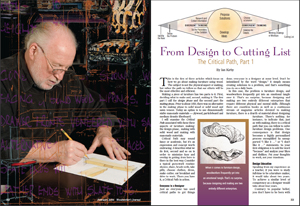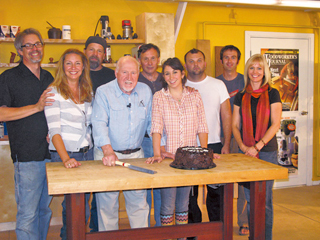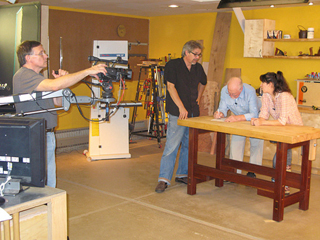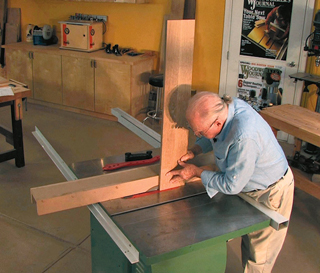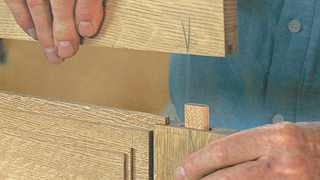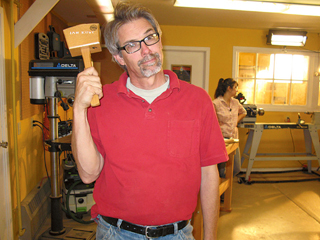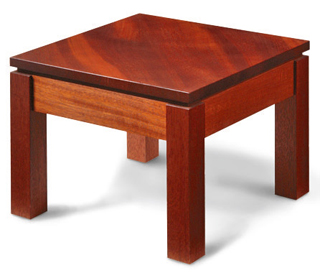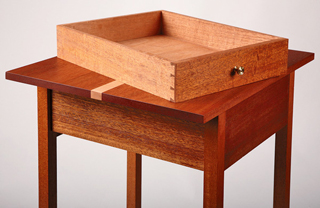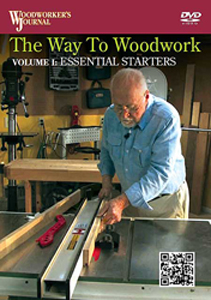
This past summer, our magazine undertook an ambitious new venture, trading try squares for clapperboards to film The Way to Woodwork three-part DVD series. In this brand-new instructional course, master woodworker Ian Kirby and LiLi Jackson teach the fundamentals of Kirby’s Critical Path woodworking methodology that we’ve been sharing in print for many years.
This video curriculum is foundationally complete in the sense that Kirby and Jackson explain the tenets of his systematic approach by building a series of projects for viewers to see. I wasn’t on set to witness the filming process, so recently I sat down with Woodworker’s Journal’s editor in chief Rob Johnstone and our publisher, Larry Stoiaken, to learn more about it. Here’s what both have to say about this informative and ground-breaking new production.
What makes The Way to Woodwork unlike other woodworking instructional videos currently on the market?
LS: Ian Kirby. It occurred to us that not since Tage Frid’s 1979 book series, Tage Frid Teaches Woodworking, has there been a no-nonsense, systematic offering for all levels of woodworking hobbyists.
RJ: To my mind, the most important difference is the history of Ian’s methodology and the media that we’ve used to present it. For many years now, Ian has been organizing and codifying the methodology he calls the Critical Path of solid-wood woodworking. The source of this system goes back to the woodworkers of the British Arts & Crafts movement. The goal of their work was to make the best furniture from the best quality materials and do it in the most efficient way that could be devised. So the methods we are teaching are the result of continuous process improvement developed by thousands of craftsmen over many decades of work. That alone is amazing. But then take Ian’s remarkable skills as a woodworker and designer, and blend them with his training as an educator (he was a professor at London University), and it gets even better. Add LiLi Jackson to the mix — who brings her own talent and woodworking knowledge to bear — and the package becomes even more valuable.
What is the reasoning for the series to be co-taught by both Ian and LiLi?
LS: At first blush, it might look like an unlikely pairing, but it was quite deliberate. Ian is a master woodworker and excellent educator, but he has been involved with woodworking for more than 50 years. So, of course, he can do all this remarkable woodworking. LiLi, in this effort, represents the “everyperson” woodworker. Her task is to show that these techniques and lessons are within the reach of Joe and Josephine woodworkers regardless of their present skill levels. I think it is a great approach.
Why a DVD format instead of a book or a book series?
LS: Rob has been presenting Ian’s work for some time in Woodworker’s Journal magazine. We recently put all of his articles together in a three-ring binder, and it was pretty impressive. Rob made the intuitive leap that a video with Ian would be the ideal approach to presenting this material. I suggested that our readers/viewers might appreciate someone closer to their skill level to complement Ian during these presentations. It so happened that we’ve also worked with LiLi Jackson over the years and knew that she and Ian would have great chemistry: the teacher and the student. It worked even better than we had hoped. They’ve become great friends.
RS: With DVDs, the information is not only presented verbally, but it also is demonstrated on real-life projects. In my opinion, this is pretty amazing stuff. And, it’s not just a DVD curriculum. There’s quite a bit more to this offering. We have created over 300 pages of supporting documents, all of which are now available and dovetail perfectly with the information presented in these three DVDs. This effort really is comprehensive.
I’m sure most woodworkers — myself included — have no idea what goes into putting a video series together. Tell me about it.
RJ: Well, let me tell you, in this case, it was quite an undertaking. We determined early on that we wanted really good production values. Delivering high quality woodworking information via a video that looked like my Uncle Jim shot it on a Super 8 was not going to be an option. But as I quickly learned, you get what you pay for in video production, as with so many other things in life. We hired JoAnne Liebeler, a top-notch writer and producer, who turned out to be a true professional and a wonderful person as well. (You might remember her as one of the hosts of the PBS Hometime series, with Dean Johnson.) “JoJo” lead the way through the video process, and we assembled a team of folks that really pitched in and worked exceptionally hard to make these DVDs come together. We also needed a set on which to shoot. To make a long story short, we ended up using my home shop (the rent was quite reasonable!), but sprucing it up considerably. We completed the set building on a Sunday and shooting started the following Monday morning. Whew!
What was it like to be a “on set” filming Woodwork?
RJ: Of course, there were some fun and funny moments during shooting, but what I learned about video production is that it is just a lot of hard work. And I think that is especially true for a video that contains as much information as we were stuffing into every minute. But with that said, we did start every scene with “Action!” and end it with “Cut!” Everyone has to be extremely quiet — but fortunately, there is a lot of good food on the set. (I gained 10 pounds!)
How many shooting days did it take to accomplish all three parts of the series? When did the shooting begin and end?
RJ: There were 14 days of shooting at least eight hours a day. We had two cameras rolling, so we ended up with close to 200 hours of video to edit down to about three hours. Nearly every scene was shot four to eight times, from different angles and with different emphasis. The first shoot was in July, and the final shooting was in September. But of course, the preparation and the post-production phases of the effort covered many more days and hours than filming. (Did I mention that this was a really big job?)
Share a brief overview of the content in each of the three DVDs. What would you consider to be some of the highlights?
RJ: The first DVD introduces Ian Kirby’s Critical Path, and it deals with basic concepts like stock preparation, measuring tools and butt joints. Ian also teaches how to lay out and form a mortise and tenon joint. Then all those concepts are used to make, in my opinion, the world’s nicest step stool. Ian also gives a great lesson on using a hand plane in this video. I would like to pause here to say that even a really good woodworker will learn so much from this first DVD — just the section on “Harvesting Stock” is worth the price of admission.
The second DVD builds on the lessons from the first, demonstrating advanced layout and wood shaping while making a small table. Then it gets into frame and panel construction — the building blocks of casework. Ian and LiLi build an elegant bookcase using those methods.
The third DVD focuses on more sophisticated casework construction and teaches how to hang a cabinet door. Then, the team moves onto making dovetails — LiLi with a router and Ian by hand. The segment of Ian making a dovetailed drawer is just amazing.
LS: So if you think about it, this series takes a person from harvesting a good piece of raw wood to making single lap and through hand-cut dovetails. It is truly comprehensive.
Are each of the three parts of this series capable of standing on their own?
RJ: When we created the outline and got to work, it was our intention that each would be able to stand on its own. But having spent many hours with these lessons — and I’m a pretty good woodworker — I’m convinced that the series is best enjoyed as a whole.
What has been the most challenging aspect of orchestrating this video series? What’s been most rewarding?
RJ: This was a very large effort with hundreds of moving parts. Getting all the details right — I like to call it moving from chaos to order — that was a challenge. There are many rewarding aspects to this work. Getting Ian’s methodology collected and presented in the best possible way is something that has been a goal of mine for a long time. It is the best woodworking process I’ve found in 40-odd years of woodworking. But in addition to that, I am tremendously proud of what our team achieved. Their efforts were extreme and the high quality of this new series is a direct result of that dedication and hard work.
Looking ahead, are there plans for creating more instructional videos with Ian Kirby?
RJ: Holy cow, let me recover from this one first!
LS: Yes…
Editor’s Note: The Way to Woodwork can be ordered now by clicking here. Each volume of the three-part DVD series is available for $29.99, or you can purchase the full set for $49.95.
